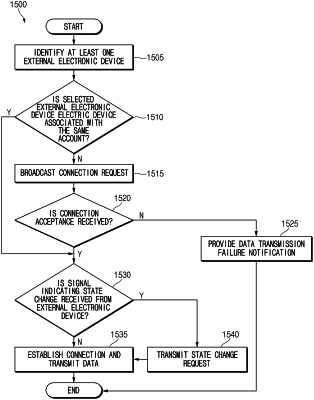| CPC H04W 4/80 (2018.02) [H04L 67/06 (2013.01); H04W 4/23 (2018.02); H04W 52/0235 (2013.01); H04W 76/14 (2018.02)] | 18 Claims |

|
1. An electronic device comprising:
a first communication circuit;
a second communication circuit configured to support a wireless protocol different from the wireless protocol supported by the first communication circuit;
a display;
a processor operatively connected to the first communication circuit, the second communication circuit, and the display; and
a memory operatively connected to the processor,
wherein the memory stores one or more instructions that, when executed, cause the processor to:
identify at least one external electronic device by using the first communication circuit based on a request for transmitting data,
establish, using the first communication circuit, a first connection with a first external electronic device among the at least one external electronic device,
receive, using the first communication circuit, state change information from the first external electronic device through the first connection before transmitting the data to the first external electronic device, the state change information indicating that the first external electronic device has transitioned from a first state to a second state consuming less power than the first state,
transmit, to the first external electronic device, a state change request for causing the first external electronic device to transition to the first state based on receiving the state change information through the first connection,
establish, using the second communication circuit, a second connection with the first external electronic device after transmitting the state change request, and
transmit, through the second connection, the data to the first external electronic device by using the second communication circuit.
|